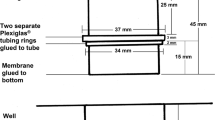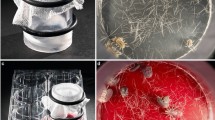Abstract
Nymphs of the brown ear tick, Rhipicephalus appendiculatus, were fed on heparinised bovine blood infected with Theileria parva parasites in an in vitro feeding system consisting of rabbit skin membranes. The main feeding and development parameters such as the mean attachment rate, feeding duration and engorgement weights of membrane-fed ticks were not significantly different from nymphs fed on cattle. The moulting rate was also comparable although a slight significant difference was observed. Assessment of infection prevalence and abundance with T. parva in adults indicated that the membrane-fed ticks acquired infection to the same level as those fed on cattle. Stabilates prepared from both the membrane- and cattle-fed adult ticks were found to be infective and caused severe reactions in susceptible cattle. When the immunised cattle were challenged with a lethal homologous dose of T. parva (Marikebuni), they were found to be immune.
Similar content being viewed by others
References
Anon 1989. Classification of Theileria parva reactions in cattle. Theileriosis in eastern, central and southern africa. In: Dolan T.T. Proc. Workshop East Coast Fever Immunisation, 20–22 September 1988, Lilongwe, Malawi, International Laboratory on Animal Diseases, Nairobi, pp. 182–186.
Anon 1994. National Agricultural Research Project, KARI/ODA: support to research into the field application of East Coast Fever immunisation and the epidemiology of related tick-borne diseases in cattle. Protozoology Division, Kenya Agricultural Research Institute, National Veterinary Research Centre, Muguga Kenya, Quarterly Report 11, July-September 1995, pp. 2–3.
Bailey K.P. 1960. Notes on the rearing of Rhipicephalus appendiculatus and their infection with Theileria parva for experimental transmission. Bull. Epizootic. Dis. Afr. 8: 33–43.
Burtler J.F., Hess W.R., Endris R.G. and Holscher K.H. 1982. In vitro feeding of Ornithodoros moubata ticks for rearing and assessment of disease transmission. In: Griffiths D.A. and Bouman C.E. (eds) Proc. 6th Congr. Acarol., Edinburgh, UK. Vol. 2, pp. 1075–1081.
Buscher G. and Otim B. 1986. Quantitative studies on Theileria parva in the salivary glands of Rhipicephalus appendiculatus adults: quantitation of and prediction of infection. Int. J. Parasitol. 16: 93–100.
Cunningham M.P., Brown C.G.D., Burridge M.J. and Purnell R.E. 1973. Cryopreservation of infective particles of Theileria parva. Int. J. Parasitol. 3: 583–587.
Eckert J. 1997. Alternatives to animal experimentation in parasitology. Vet. Parasitol. 71: 99–120.
Goddeeris B.M., Katende J.M., Irvin A.D. and Chumo R.S.C. 1982. Indirect fluorescent antibody test for experimental and epizootiological studies on East Coast Fever (Theileria parva) infection in cattle: evaluation of a cell culture schizont antigen fixed and stored in suspension. Res. Vet. Sci. 33: 360–365.
Norval R.A.I. and Young A.S. 1989. Problems in tick control and its modification after immunisation. In: Young A.S., Mutugi J.J. and Maritim A.C. (eds). Progress Towards the Control of East Coast Fever (Theileriosis) in Kenya. Kenya Agricultural Research Institute, Nairobi, pp. 88–94.
Norval R.A.I., Perry B.D. and Young A.S. 1992. The Epidemiology of Theileriosis in Africa. Academic Press, London.
Perry B.D. and Young A.S. 1995. The past and future role of epidemiology and economics in the control of tick-borne diseases of livestock in Africa. Prev. Vet. Med. 25: 107–120.
Radley D.E., Brown C.G.D., Burridge M.J., Cunningham M.P., Kirimi I.M., Purnell R.E. and Young A.S. 1975. East Coast Fever: 1. Chemoprophylactic immunisation of cattle against Theileria parva (Muguga) and five theilerial strains. Vet. Parasitol. 1: 35–41.
Schoin R., Hess E., Blum W. and Ramstein K. 1984. The aggregation-attachment pheromone of the tropical bont tick Amblyomma variegatum Fabricius (Acari: Ixodidae): isolation, identification and action of its components. J. Insect. Physiol. 30: 613–618.
Voigt W.P., Young A.S., Mwaura S.N., Nyaga S.G., Njihia G.M., Mwakima F.N. and Morzaria S.P. 1993. In vitro feeding of instars of the ixodid tick Amblyomma variegatum through skin membranes and its application to the transmission of Theileria mutans and Cowdria ruminantium. Parasitology 107: 257–263.
Waladde S.M. and Ochieng S.A. 1992. Advances in the artificial feeding of ticks. Insect Sci. Appl. 13(4): 579–583.
Waladde S.M., Kemp D.H. and Rice M.J. 1979. Feeding electrograms and fluid uptake measurements of the cattle tick Boophilus microplus attached on artificial membranes. Int. J. Parasitol. 9: 89–95.
Waladde S.M., Ochieng S.A. and Gichuhi P.M. 1991. Artificial-membrane feeding of the ixodid tick, Rhipicephalus appendiculatus, to repletion. Exp. Appl. Acarol. 11: 297–306.
Waladde S.M., Young A.S., Ochieng S.A., Mwaura S.N. and Mwakima F.N. 1993. Transmission of Theileria parva to cattle by Rhipicephalus appendiculatus adults fed as nymphae in vitro on infected blood through an artificial membrane. Parasitology 107: 249–256.
Waladde S.M., Young A.S., Mwaura S.N., Njihia G.M. and Mwakima F.N. 1995. Optimisation of the in vitro feeding of Rhipicephalus appendiculatus nymphae for the transmission of Theileria parva. Parasitology 111: 463–468.
Waladde S.M., Young A.S. and Morzaria S.P. 1996. Artificial feeding of ixodid ticks-reviews. Parasitol. Today 12: 272–278.
Winrock International 1992. Assessment of animal agriculture in Sub-Saharan Africa. Winrock International Institute for Agricultural Development, Morrilton, Arkansas.
Author information
Authors and Affiliations
Corresponding author
Rights and permissions
About this article
Cite this article
Musyoki, J.M., Osir, E.O., Kiara, H.K. et al. Comparative studies on the infectivity of Theileria parva in ticks fed in vitro and those fed on cattle. Exp Appl Acarol 32, 51–67 (2004). https://doi.org/10.1023/B:APPA.0000018159.47700.e4
Issue Date:
DOI: https://doi.org/10.1023/B:APPA.0000018159.47700.e4




